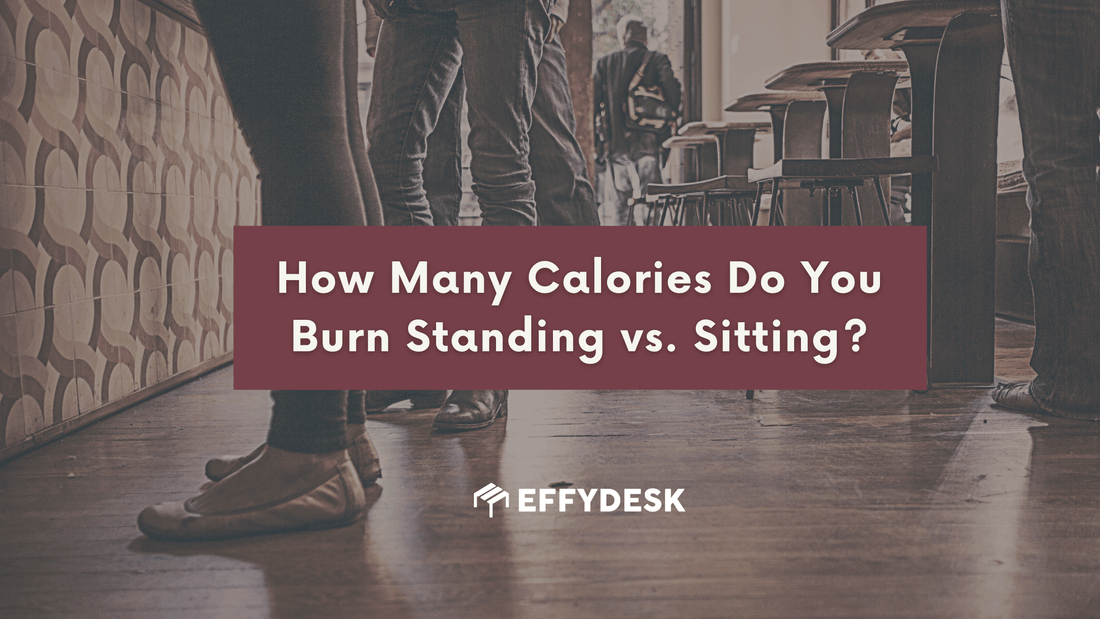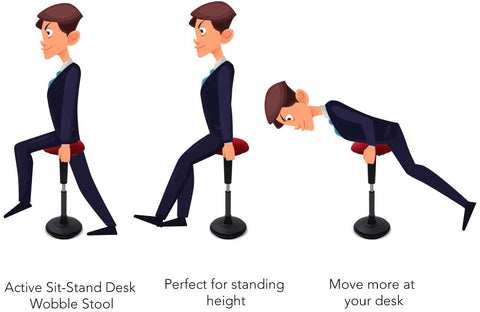
How Many Calories Do You Burn Standing vs. Sitting?
EFFYDESK TEAMShare

If you have a desk job, you've likely heard about the downsides of sitting all day. Extended sitting time affects our posture, wellness, and overall lifespan. Research shows that sitting for long periods is linked to a higher risk of developing Type 2 diabetes and heart disease.
Many people working from home have upgraded to electric sit-stand desks. At the push of a button, you can switch from sitting to standing whenever you want! Using a standing desk gives you the freedom to change working positions throughout the day, effectively countering the sedentary habits that many of us have developed.

We're here to help you understand how your work position affects your energy use and wellness. We've already covered some FAQs asked by Reddit's standing desk community, and today we're tackling one of the most common questions about adjustable standing desks:
How Many Calories Do You Burn Standing vs. Sitting?
When comparing calories burned sitting versus standing, the difference might surprise you. For a person weighing around 143 pounds, standing burns approximately 8-10 more calories per hour compared to sitting. While this might seem modest at first, it adds up over time.
If you stand for six hours a day instead of sitting, you could burn an additional 54 calories daily. Over several months, this small change could support your weight management goals. The difference per hour is subtle, but the cumulative effect of standing more can contribute to your overall energy balance. However, you need to be mindful of how long you should stand up while working to burn the most calories.

The exact number of calories you burn while sitting or standing depends on your height, weight, age, and sex. Your body burns calories through basic functions like breathing and food processing, which vary based on factors such as muscle mass and age. Every person burns calories at a different rate.
On average, you burn about 100-200 calories per hour while standing, and only 60-130 calories while sitting. This means using a standing desk helps you burn more calories than you would sitting down. Working at an electric sit-stand desk can increase the calories burned by 40-70 calories per hour.
Curious about how many calories you burn at rest? Use this handy calculator to get an idea of your Basal Metabolic Rate.
Beyond Calories: The Health Benefits of Standing
Standing offers several benefits that support wellness beyond just burning a few more calories:
-
Improved muscle tone and posture: Standing engages your core and leg muscles, promoting better posture and muscle maintenance
-
Enhanced blood flow: Standing helps support normal circulation in your feet and legs
-
Reduced health risks: Less sitting time can help lower the risk of health problems associated with sedentary behavior
-
Increased activity level: When you're already on your feet, you're more likely to move around throughout the day
By incorporating more standing into your workday, you're not just burning more calories—you're taking a proactive step toward better overall health and energy balance.
Does a Standing Desk Help You Lose Weight?
The straightforward answer is that simply using a standing desk won't lead to significant weight loss on its own. The extra calories you burn by standing instead of sitting isn't enough to make a substantial difference. Using a standing desk might help maintain your current weight and prevent weight gain, but the calories burned won't necessarily lead to weight loss without other physical activities.
To lose weight, you need to burn more calories than you eat, among other simple changes. To gain weight, you must consume more calories than your body uses for energy. Understanding your daily energy needs and dietary habits is essential for weight management.

However, don't overlook the health benefits of standing! Keeping on your feet while you work improves your circulation and posture. Plus, you're much more likely to move around or take a short walk if you're already standing. When you're sitting, finding the motivation to get up can be challenging, but if you're already on your feet—why not take a brief stroll?
How to Burn More Calories at Work
If increasing calories burned is your goal, try incorporating simple strategies into your workday to keep your body more active. Start by mixing sitting and standing throughout the day. Changing positions every 30-60 minutes keeps your muscles engaged and your metabolism more active than staying in one position.
Add movement whenever possible during your workday. Perform light exercises like shoulder rolls, seated leg lifts, or desk push-ups throughout the day to keep your blood flowing. These small movements add up when it comes to burning calories.
Try active sitting as another way to increase energy use while working. Using a balance ball or wobble stool creates constant, light movement that engages your core muscles and increases calories burned compared to static sitting.
Even doing strength-building activities for just 20 minutes at your desk can engage your muscles and increase calories burned while you work. Calf stretches, leg extensions, and back twists don't require much space or time but offer excellent ways to support muscle tone and energy use during your workday.

Simple movements like twisting, leaning, and changing positions throughout the day can burn calories similar to light physical activity. Sitting on a balance ball or a wobble stool also helps build core strength. (Check out our complete guide to active sitting!)
Tracking Your Activity Level
Monitoring your movement can be motivating and help you stay consistent with healthy habits throughout your workday. Many people find that measuring progress helps them maintain their commitment to healthier work patterns.
Activity trackers offer one popular approach to monitoring calories burned. Wearable devices or phone apps can estimate energy use based on your height, weight, and activity intensity. These tools make it easy to see how standing versus sitting affects your daily calorie burn.
MET values provide another way to measure your activity. These values compare the energy used during various activities to your resting energy use. Standing typically has a higher MET value than sitting, helping you calculate how position changes affect your metabolism.
Even simple time tracking can be effective. Keeping watch of how long you stand versus sit helps you measure progress toward your movement goals. You might start with 30 minutes of standing time and gradually increase as your body adapts.
By using these tracking approaches, you can better understand your activity patterns and make informed choices to help you burn more calories and feel more energized throughout your day.
Creating a Balanced Approach to Work and Movement
The key to staying active at work isn't about standing all day—it's about finding the right balance and introducing variety into your routine. Your body benefits most when you alternate between different positions rather than remaining static for extended periods.
Start with short standing periods of 15-30 minutes and gradually increase as your body adapts. Many people find that their feet and legs need time to adjust to longer periods of standing, especially if they've primarily been sitting for years. Patience with this adjustment process pays off as your stamina builds.
Listen to your body's signals throughout the workday. Some days you might need more sitting time than others, and that's perfectly normal. Forcing yourself to stand when you're experiencing discomfort can create negative associations with your standing desk.
Combine standing with regular breaks for walking or stretching to maximize calories burned. Even a quick two-minute walk every hour adds movement that sitting alone can't provide. These micro-breaks refresh your mind while giving your body different movement patterns.
Support your feet with a comfortable mat when standing to reduce fatigue and increase comfort. A quality anti-fatigue mat can make the difference between enjoying your standing desk and avoiding it.
Ensure your desk height is properly adjusted for both sitting and standing positions. Correct ergonomics prevents strain and allows you to maintain each position longer without discomfort.
This balanced approach helps you gain the benefits of both positions while avoiding potential discomfort from too much of either. Remember that the goal isn't to eliminate sitting—it's to break up long periods of inactivity with movement that keeps your body energized and healthy.
To Sum It All Up...
Standing desks won't revolutionize your weight loss journey overnight, but they'll help you burn more calories through increased movement and activity. They can help reduce the health risks linked with extended sitting, such as heart disease and diabetes. You'll be more likely to walk around and keep your body active, which helps you feel more energized and focused throughout your day.
When you're not burning calories while standing or using a wobble stool, take a break in Canada's favorite ergonomic office chair. Balance is key!
Looking to upgrade your workspace in the upper western part of the US? EFFYDESK is available in locations like Denver, Los Angeles, and others providing ergonomic solutions tailored to your needs.
Looking to Boost Your Energy and Comfort While Working? EFFYDESK Can Help!

At EFFYDESK, we create and deliver thoughtfully designed electric standing desks for both professional and personal use.
If you're looking for ways to feel better while you work, we're here to help! Our standing desks support physical activity and can help lower the risk of various health conditions related to extended sitting.
Our collection of electric standing desks and ergonomic office chairs is designed to improve your comfort, enhance your posture, and help you do your best work—wherever your office happens to be.
Browse our Standing Desks, Office Chairs, and Monitor Mounts created to support both your health and productivity.
To learn more about EFFYDESK's products and services, check out our FAQ page or explore the blog archive for other helpful articles on creating a more comfortable and energizing workspace.